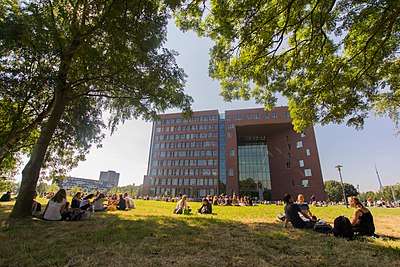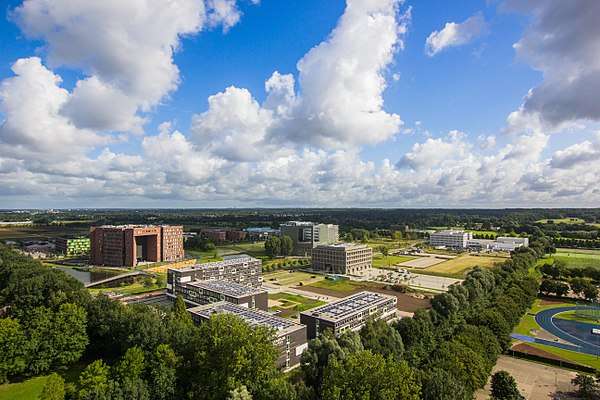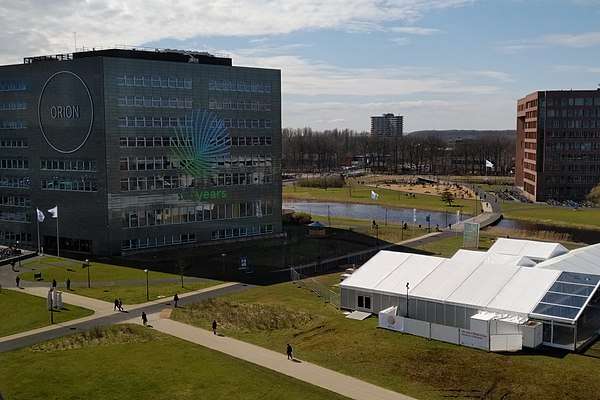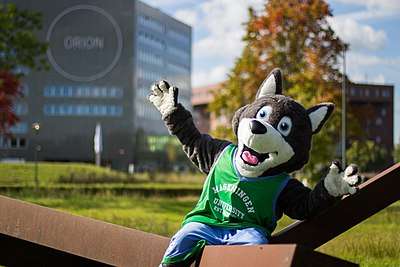Wageningen University and Research
|
Wageningen University & Research | |
|
| |
| Motto | To explore the potential of nature to improve the quality of life |
|---|---|
| Type | Public university |
| Established | 1876 as an agricultural college. Recognized in 1918 as a public university |
| Rector | Arthur Mol |
| Executive Board President | Louise Fresco |
| Students | 12001 (2017-18) |
| Undergraduates | 5659 (2017-18) |
| Postgraduates | 5821 (2017-18) |
Other students | 521 (2017-18) |
| Address | Droevendaalsesteeg 4, 6708 PB Wageningen, Wageningen, Netherlands |
| Student nationalities | 103 (40% of the postgraduates) |
| Colours | Blue and Green |
| Affiliations | Euroleague for Life Sciences, EUA, 4TU |
| Mascot | WUR Wolf |
| Website |
www |
Wageningen University & Research (also known as Wageningen UR; abbreviation: WUR) is a Dutch public university in Wageningen, Netherlands. It consists of Wageningen University and the former agricultural research institutes (Dienst Landbouwkundig Onderzoek (DLO)) of the Dutch Ministry of Agriculture. Wageningen University & Research trains specialists (BSc, MSc and PhD) in life and social sciences and focuses its research on scientific, social and commercial problems in the field of life sciences and natural resources. In the field of life sciences, agricultural and environmental science, the university is considered world-class.[1][2][3] According to the Times Higher Education World University Rankings it is the best university in the Netherlands and No. 1 worldwide, in agriculture and forestry for 2017 on the QS World University Rankings charts.[4] The university has about 12,000 students from over 100 countries. It is also a member of the Euroleague for Life Sciences (ELLS) university network.
History
In 1876 the Rijkslandbouwschool (National Agricultural College) was established in Wageningen. Due to the development of the training to a higher educational level it changed in 1896 to the Hoogere Land- en Boschbouwschool (Agricultural and Forestry College) and in 1904 in Rijks Hoogere Land-, Tuin- en Boschbouwschool (National Agricultural, Horticulture and Forestry College).
In 1918 the school became academic by law (Academic Education Act). The name changed to Rijks Landbouw Hoogeschool (National Agricultural College). The openings date and official Dies natalis is 9 March 1918.
In 1986 the "hogescholen" (comparable to scientific institute of technology) were renamed to University in a modification of the Academic Education Act. The new name became Landbouwuniversiteit Wageningen (LUW) (Wageningen Agricultural University (WAU)). The 1986 law changes resulted in the use of the name hogeschool in the Dutch system to be used exclusively for universities of applied science.
Over the years the research and teaching branched out into life sciences in general; while interest for agriculture as a career opportunity waned. In 1997, when the DLO institutes merged with the university, the new holding was rebranded as Wageningen UR (Wageningen University and Research Centre); with the University being renamed Wageningen University. Under the Dutch laws the University and the institutes had to remain separate legal entities.
In 2006, the university of applied sciences Van Hall Larenstein became part of Wageningen UR. The idea was to create better collaboration between applied teaching and research at Van Hall and the academic research at Wageningen University. This would also support students to continue with an academic program upon completing their applied degree. However, due to differences in organizational culture and incompatibility of procedures for the different types of higher education, collaboration between the two schools remained problematic. In 2012 it was decided that Van Hall Larenstein would leave Wageningen UR and continue as an independent school once more. In the spring of 2015 the separation was marked by the move of the final Wageningen-based Van Hall Larenstein studies back to Velp.
In 2009 it was decided that the University would consistently use the English name in its communication. In addition university research could be presented under the name of the university: Wageningen University (WU) (as an alternative of using the name of the holding Wageningen UR).[5][6] On 6 September 2016 Wageningen University and the research institutes decided to continue as one, jointly brand: Wageningen University & Research (WUR). On 9 March 2018 Wageningen University & Research celebrates her 100 years anniversary. During this year there are many events and festivities around the campus and in the city of Wageningen.
Academic profile
Wageningen University & Research was the first Dutch university or school that was allowed to use the European Credit Transfer and Accumulation System (ECTS) label. This label is awarded by the European Commission and guarantees the quality of the study programme. An important consideration is that the university consequently applies the European Credit Transfer System; this promotes the mobility of students within Europe and prevents study delay. The label is an acknowledgement of the international character of the university. Out of 56 European applications in 2005, only three ECTS labels were awarded.
BSc programmes

Wageningen University & Research offers 19 BSc programmes[7] (2018-2019). The language of instruction is partly Dutch, partly English. For some BSc programmes the language of instruction is English. The programmes start each year in September, they last three years and consist of 180 ECTS credits. The programmes are in the field of economy and society, health, life sciences and technology, nature and environment, animals and plants.
List of BSc programmes offered in English during the 2018-2019 academic year:
- Animal Sciences
- Environmental Sciences
- Food Technology
- International Land and Water Management
- Soil, Water, Atmosphere
- Tourism
List of BSc programmes offered in Dutch during the 2018-2019 academic year:
- Agrotechnologie
- Bedrijfs- en Consumentenwetenschappen
- Biologie
- Biotechnologie
- Bos- en Natuurbeheer
- Communicatie en Life Sciences
- Economie en Beleid
- Gezondheid en Maatschappij
- Internationale Ontwikkelingsstudies
- Landschapsarchitectuur en Ruimtelijke Planning
- Moleculaire Levenswetenschappen
- Plantenwetenschappen
- Voeding en Gezondheid
MSc programmes

Wageningen University & Research offers a 36 different MSc programmes[8] (2017-2018) and two online masters programs.[9] The language of instruction is English. The programmes start each year in September, they last two years and consist of 120 ECTS credits. Most programmes offer various specializations and possibilities for majors.
List of MSc programmes offered during the 2017-2018 academic year:

- Agroecology (European)
- Animal Sciences
- Aquaculture and Marine Resource Management
- Biobased Sciences
- Bioinformatics[10]
- Biology
- Biosystems Engineering
- Biotechnology
- Climate Studies
- Communication, Health and Life Sciences
- Development and Rural Innovation
- Earth and Environment
- Environmental Sciences
- Food Quality Management
- Food Safety
- Food Studies (European)
- Food Technology
- Food Technology (online)
- Forest and Nature Conservation
- Geographical Information Management and Applications
- Geo-information Science
- International Development Studies
- International Land and Water Management
- Landscape Architecture and Planning
- Leisure, Tourism and Environment
- Management, Economics and Consumer Studies
- Metropolitan Analysis, Design, and Engineering
- Molecular Life Sciences
- Nutritional Epidemiology and Public Health (online)
- Nutrition and Health
- Organic Agriculture
- Plant Biotechnology
- Plant Breeding (online)
- Plant Sciences
- Urban Environmental Management
- Water Technology
PhD programme
The PhD programme is a four-year programme which consists of a research component and a smaller education component. To apply for a PhD position, the applicant must contact one of the six Graduate Schools of Wageningen University & Research.[11] In order to guarantee adequate supervision, the research subject must fit in the research programme of a Graduate School.
The four-year PhD programme consists of a research component (conducting research under supervision and writing a thesis) and a smaller education component (up to 15 percent of the total PhD time).
Upon completion of PhD programme, the PhD student is expected to be:
- Able to function as an independent scientist.
- Able to integrate his or her own work in the theoretical framework of his or her discipline in a broader area of research and able to communicate this in a scientific or general setting.
- Competent in identifying priority areas of research and in formulating questions and experimental hypotheses pertinent to this research.
Research Institutes
The following research institutes are part of Wageningen University & Research:
- Wageningen Environmental Research (Alterra), formerly Alterra[12]
- Wageningen Economic Research, formerly LEI Wageningen UR[13]
- Wageningen Bioveterinary Research, formerly Central Veterinary Institute[14]
- Wageningen Centre for Development Innovation, formerly Centre for Development Innovation[15]
- Wageningen Food & Biobased Research, formerly Food & Biobased Research[16]
- Wageningen Livestock Research[17]
- Wageningen Marine Research, formerly IMARES[18]
- Wageningen Plant Research[19]
- RIKILT[20]

Rankings
International Rankings
| University rankings | |
|---|---|
| Global | |
| ARWU World[21] | 101-150 |
| Times World[22] | 64 |
| USNWR World[23] | 88 |
| QS World[24] | 124 |
- In the 2017/2018 National Taiwan Ranking[25] Wageningen University & Research is ranked first in the field of agriculture.[26]
- In the 2017/2018 National Taiwan Ranking[25] Wageningen University & Research is ranked first in the field of Environment & Ecology.[27]
- In the 2016 Shanghai Ranking Wageningen University & Research was ranked in the bracket 101-150th best universities in the world overall[28] and 36th best in the domain of life and agriculture sciences.[29]
- In the 2017 Times Higher Education World University Rankings[30] Wageningen University & Research was ranked 25th overall in the world and 16th in life sciences.
- In the Academic Ranking of World Universities 2017[31] Wageningen University & Research is ranked first in the field of Food Science & Technology.[32]
- In the 2016/2017 QS World University Rankings, Wageningen University & Research was ranked 119th overall in the world, first in the field of agriculture and forestry, fourth in environmental science, 13th in development studies, and 83rd in life sciences and medicine.[33]
National rankings
- The Dutch 'Keuzegids' ranking compares Dutch universities based on reviews by their own students. In 2018 Wageningen University & Research is ranked as the best university in the Netherlands in full-time education for the 13th time in a row.
- In 2015 Wageningen University & Research was awarded as the most sustainable Dutch University by Morgen (organization), for the third time in a row.
100 years Wageningen University & Research

On 9 March 2018 Wageningen University & Research celebrates her 100th Dies Natalis. This is the start of the anniversary year with lots of events and festivities. Within the themes of life, food and earth, numerous activities are planned in which science, art, sports and business are brought together. The 100 years WUR events[34] take place at different locations, both inside and outside the campus.
Student activities and associations

- Aktief Slip is the study association for students participating in the study programmes Milieuwetenschappen (BMW), Environmental Sciences (MES), Climate Studies (MCL) and Urban Environmental Management (MUE). The name is in Dutch and originates from the bacteria containing material (active sludge), that is used to clean wastewater. It was founded in 1966.
- M.S.V. Alchimica is the study association for students Molecular Life Sciences. Since 1970 it has been organising different activities for its members.[35]
- B.V.W. 'Biologica' is the study Association for all Biology Students.
- CODON is the study Association for all Biotechnology students. Established by the first students of Bioprocesstechnology on 16 September 1991. At that time the association carried the name "BiPS" which was later changed to CODON. The association's main language is Dutch and in the past has been criticised for excluding international students.
- Di-Et-Tri is the study Association for Nutrition and health students. The name is a play on words for the Dutch word for diet ('dieet').
- Genius Loci is the study Association for students Landscape Architecture and Spatial Planning. The name reflects the atmosphere of a certain place. It was founded on February 15, 1990 after the merger of two older study programmes.
- Heeren XVII is the study Association for Agrotechnology students. It was founded on 1 April 1965.
- Ipso Facto is the study association for the students of International Development Studies and Communication Studies. It was created in 2000 when the study 'international culture techniques' split up in 'international land and water management' and 'international development studies'.
- Licere is the study association for the students of the MSc Leisure, Tourism and Environment. It was founded in 2006 and its name means 'Leisure time' in Latin.
- Mercurius is the study association for students of Management & Consumer studies, Economics & Governance and Health & Society. It was created in 2000 when several study associations merged, but the association celebrated its 50-year anniversary in November 2012, as it considers the Dies Natalis of the former separate associations to be its own Dies Natalis. The association has nearly 900 members, making it one of the largest study associations in Wageningen.
- Nicolas Appert is the study Association for Food Technology students. It was founded on 6 September 1962, and was named after the French food scientist Nicolas Appert.
- Nitocra is the study association for students International land and water management.
- Pyrus is the study association for students Soil, water and atmosphere.
- Semper Florens is the study Association for Plant Scientists and Plant Biotechnologists.
- StEL is the study Association for Organic Agriculture students.
- WSBV Sylvatica is the study Association for students Forest and Nature conservation. It is the oldest study association in Wageningen, founded in 1939.
- De Veetelers is the study association for Animal Sciences students. The name means "Animal Breeders". It was founded in 1962.
Notable alumni (including present or former employees)
|
|
|
|
See also
References
- ↑ "Subject Ranking 2015-2016: life sciences top 100". 9 October 2015.
- ↑ "QS World University Rankings by Subject 2015 - Environmental Sciences". 22 April 2015.
- ↑ Viviano, Frank (September 2017). "This Tiny Country Feeds the World". National Geographic. Retrieved 1 September 2017.
- ↑ "QS World University Rankings by Subject 2016 - Agriculture & Forestry". 17 March 2016.
- ↑ "Wageningen Universiteit (WU)" (in Dutch). Studie.nl. Archived from the original on 2012-11-07. Retrieved 6 March 2013.
- ↑ "History of Wageningen UR". Wageningenur.nl. Retrieved 6 March 2013.
- ↑ "Bachelor's".
- ↑ "Master's".
- ↑ "Student Service Centre - Wageningen UR". Wageningenuniversity.nl. Retrieved 2013-07-09.
- ↑ "Master's Bioinformatics".
- ↑ "PhD Programme - Wageningen UR". Wageningenuniversity.nl. Retrieved 2013-07-09.
- ↑ "Wageningen Environmental Research - Wageningen UR". Wageningenur.nl. Retrieved 2016-09-30.
- ↑ "Wageningen Economic Research - Wageningen UR". Wageningenur.nl. Retrieved 2016-09-30.
- ↑ "Wageningen Bioveterinary Research - Wageningen UR". Wageningenur.nl. Retrieved 2016-09-30.
- ↑ "Wageningen Centre for Development Innovation - Wageningen UR". Wageningenur.nl. Retrieved 2016-09-30.
- ↑ "Wageningen Food & Biobased Research - Wageningen UR". Wageningenur.nl. Retrieved 2016-09-30.
- ↑ "Wageningen Livestock Research - Wageningen UR". Wageningenur.nl. Retrieved 2016-09-30.
- ↑ "Wageningen Marine Research - Wageningen UR". Wageningenur.nl. Retrieved 2016-09-30.
- ↑ "Wageningen Plant Research - Wageningen UR". Wageningenur.nl. Retrieved 2016-09-30.
- ↑ "RIKILT - Wageningen UR". Wageningenur.nl. Retrieved 2016-09-30.
- ↑ "ARWU World University Rankings 2018 - Academic Ranking of World Universities 2018 - Top 500 universities - Shanghai Ranking - 2018". www.shanghairanking.com.
- ↑ "World University Rankings". 18 August 2017.
- ↑ "U.S. News Education: Best Global Universities 2018".
- ↑ "QS World University Rankings 2018". 1 February 2017.
- 1 2 http://nturanking.lis.ntu.edu.tw/Default.aspx
- ↑ "NTU Ranking, 2017 - Environment/Ecology". National Taiwan University Ranking. Archived from the original on 2017-10-11. Retrieved 2016-09-04.
- ↑ "2017 National Taiwan University Ranking (NTURanking)". nturanking.lis.ntu.edu.tw. Retrieved 2018-06-08.
- ↑ "University of Wageningen | Academic Ranking of World Universities - 2016 | Shanghai Ranking - 2016". www.shanghairanking.com. Retrieved 2016-10-06.
- ↑ "Academic Ranking of World Universities in Life and Agriculture Sciences–2016". www.shanghairanking.com. Retrieved 2016-10-06.
- ↑ "World rankings–Europe". Times Higher Education. Retrieved 2016-10-06.
- ↑ "ARWU World University Rankings 2018 - Academic Ranking of World Universities". www.shanghairanking.com.
- ↑ "ShanghaiRanking's Global Ranking of Academic Subjects 2017 - Food Science & Technology | Shanghai Ranking - 2017". www.shanghairanking.com. Retrieved 2018-06-08.
- ↑ "QS World University Rankings". Top Universities. QS Quacquarelli Symonds. Retrieved 2016-10-06.
- ↑ "100 years Wageningen University & Research".
- ↑ "M.S.V. Alchimica". Retrieved 14 April 2015.
External links
![]()
Coordinates: 51°58′01.52″N 5°39′30.97″E / 51.9670889°N 5.6586028°E